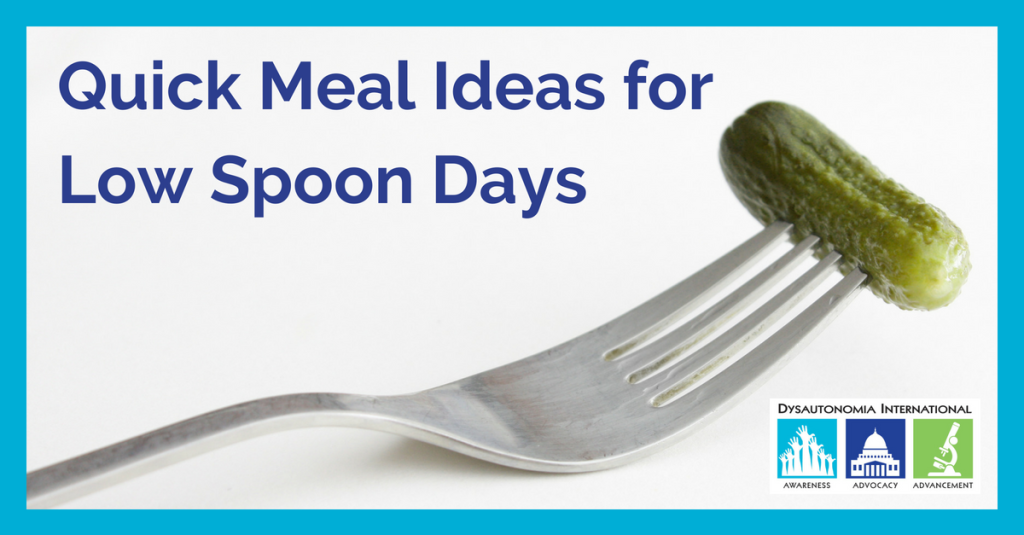Too exhausted to cook? Running low on spoons? (If you don’t know what we mean by low on spoons, check out the Spoon Theory.) Here are some meal ideas for inspiration from a fellow dysautonomia warrior.
People with dysautonomia have a lot of different dietary restrictions, so you can modify these ideas as needed. And of course, add copious of amounts of salt if your doctor has suggested a high salt diet to help manage your dysautonomia symptoms. You can find some salty diet tips here.
Leafy Green and Protein
Keeping your favorite green leafy vegetable and protein of choice on hand means you can easily throw together a salad on a low energy day. Spinach is my leafy green of choice. As for protein, my favorites are leftover pot roast, chicken breasts, tuna, or frozen veggie patties. I top it off with some hot sauce, barbeque sauce, Mexican spice blends, lemon juice, or oil and vinegar. Add whatever veggies or fruit you have on hand (berries, apple, avocado, onion, tomato, peppers, shredded carrots) and you’ve got yourself a nutritious, filling meal. Iceberg or butter lettuce with feta, kalmata olives, some olive oil dressing, makes a super salty quick Greek salad.
Chopped Veggies
Keeping chopped vegetables ready to go in my fridge or freezer allows me to eat healthier than I otherwise would on symptomatic days. Bags of store bought or home chopped frozen vegetables make throwing together a stir-fry with whatever protein I have on hand quick and easy. I also sneak a little spinach into nearly everything I cook – not enough to change the flavor, but enough to count. If you don’t mind a green tint, you can even add a little raw spinach to your smoothie without changing the flavor!
Fruit
Whether it be fresh or frozen, you probably don’t need told that eating fruit is a healthy. Eat it alone. Add it to your salad, oatmeal, or use it as a waffle topping. Dip it in chocolate, marshmallow fluff, or peanut butter. Eat it as a frozen treat or freeze it to use in your smoothie instead of ice. The possibilities are endless. Be mindful that canned fruit often harbors a lot of unnecessary added sugar.
Deli Meat
If you have a daily sodium goal, deli meats can help you meet it. The standardized reference for 4 slices of deli ham in the USDA database is listed as 491mg of sodium per 4 slices of ham. If you are aiming to consume 5 grams of salt (1965 grams sodium) per day, 4 slices of ham gets you 25% of the way there. If you aren’t in the mood for a sandwich, use it to make a lettuce wrap, roll up some slices of meat with some cheese, or put it in an omelet.
Eggs
As someone who could not eat egg for several years, I am in awe of all the easy meal options available to me thanks to eggs! If you Google “minute muffins” you will find hundreds of variations of a muffin you make in your microwave using eggs, a fat, a flour, and whatever extras (fruit, chocolate, sausage) tickle your fancy. You can make an egg sandwich, an omelet, or scramble them with cheese. Cracking an egg on a tortilla and successfully flipping it over without breaking the yolk (here is a recipe) makes me feel like a kitchen ninja, and sometimes is just the pick me up I need on a symptomatic day.
Noodles and Sauce
Not only is this a simple meal to throw together on a low energy day, it is easy to stay stocked up on your favorite jarred sauce and noodles, rice, or quinoa since they have a long shelf-life. Simply follow the directions on the box of noodles, add some butter or your sauce, and you are in business! If you are feeling ambitious, add some meat or veggies. My go to is stirring in cherry tomatoes and a few handfuls of torn up fresh spinach after adding the sauce to the noodles, then heating until the spinach is wilted.
Nut Butters
Whether you enjoy the distinctive taste of peanut butter or the milder flavor of almond butter, there is so much you can do with nut butter. Make a sandwich. Put it on a tortilla and microwave it for 30 seconds. Throw a dollop of it into a smoothie or your oatmeal to make it more satiating. Spread it onto some crackers, celery, or a banana. Use it as a dip for apple slices or pretzels. Heat it up with some soy sauce or tamari to make an Asian style sauce for noodles, snap peas, chicken or shrimp.
Hummus
We all know and love hummus for dipping pita chips into, but don’t stop there! Use it as a dip for cucumbers, celery, bell peppers, celery, or carrots. Spread it on some toast. Use it in place of mayonnaise or mustard on a sandwich to add flavor while also adding nutrients thanks to the garbanzo beans and sesame seeds used to make hummus.
Potatoes
On a low spoon day, check out your fridge for leftovers you could turn into potato toppings. Whether we are talking plain old Idaho potatoes or sweet potatoes, they are easily cooked in the microwave and are an excellent base to pile toppings onto. Popular toppings are meats (chopped ham, crumbled bacon, taco meat, chili, stew), vegetables (onions, beans, tomatoes, avocado, sautéed mushrooms, sautéed spinach), cheese, sour cream or plain greek yogurt seasoned with salt, herbs/seasonings (basil, dill, chives, chili powder) and “sauces” (salsa, cheese sauce, alfredo, pesto). If are in the mood for something sweet, top a sweet potato with chocolate, marshmallow, nut butter, cinnamon sugar, or fresh fruit like bananas or pineapple.
Yogurt & Kefir
You can eat yogurt on its own, or topped with raw fruit, fruit preserves, nuts or cacao nibs. Plain Greek yogurt is versatile – blend it into a smoothie with frozen fruit, top your potatoes with it, use it as a sour cream replacement on tacos or tortillas, use it as a base for a dip (just add salt and dill) or even use it as a sauce for chicken with some curry powder for a “too tired to cook” version of tandoori chicken.
Instant Oatmeal
When you are too tired to cook but you want a hot meal, instant oatmeal is a good option. If you have a little energy, stir cinnamon and chopped apple or raisins into your oatmeal before microwaving it. You can add a little protein to your by microwaving it with milk instead of water, or by adding almonds or walnuts.
Leftovers!
When you do have the energy to cook, or someone is kind enough to cook for you, always try to cook enough to get another meal or two out of whatever you’re making, then you can just microwave the leftovers. Miscellaneous leftovers that aren’t enough for a full meal often make great filling for quesadillas or omelets, and don’t be afraid to eat breakfast for dinner!
Chocolate Chips
This list wouldn’t be complete without something to nourish your sweet tooth. Throw some chocolate chips in your yogurt, smoothie, or trail mix blend. Spread melted chocolate chips on your toast with butter or peanut butter. Use melted chocolate chips to coat nuts or as a dip for fruit or pretzels.
My favorite way to eat chocolate chips right now is by melting them in a small dish in the microwave, stirring in frozen blueberries, and eating them with a fork. The chocolate hardens quickly when it comes into contact with the frozen blueberries, and you have chocolate covered blueberries! Adding a little coconut oil before microwaving will make your chocolate softer and less likely to stick to the dish.
If you are looking for a healthier option that still gives you a crunchy chocolate taste, try cacao nibs. They are great in yogurt, sprinkled on ice cream, or mixed in with salted nuts.
Guest author Jaclyn is a blogger and member of Dysautonomia International’s Patient Advisory Board. She is a lover of science, empowering other patients with information, and approaching life with a sense of humor.

